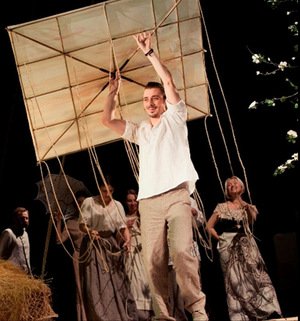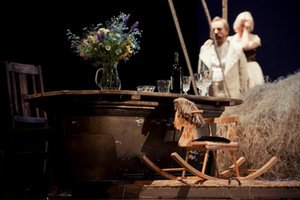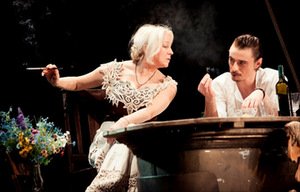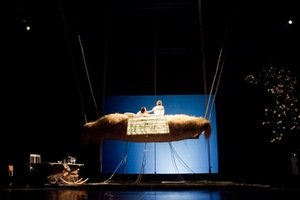Hand on curtain 1
In brief: The leader of the last, 93rd season of our theatres is Kaunas drama, for sure. This statement may be questioned subjectively but objective facts show that this is where events important for the entire system of our state theatres took place this season. The new performance “A Month in a Village”, by which the National Kaunas Drama Theatre announced the end of this historical season, is a suitable pretext for generalisations and thoughts about the latter creative cycle.
The author calls this season (not only in Kaunas) the season when theatre music predominated. Music of the live classic Vidmantas Bartulis for the performance “A Month in a Village” is a perfect illustration when music overtakes the director’s work, it creates the theatrical artistic stylisation of a certain epoch.
The intellectual realistic Russian dramaturgy of the end of the 19th century, e.g., early plays of Ivan Turgenev, Anton Chekhov, Maxim Gorky crystallised a stylistic archetype of wide meaning in the heads of the audience and theatre people. Decorations from real hay, robes of men and ladies of natural canvas shades, light hats and panamas, free mise-en-sc`enes with half-resting, half-sitting characters, wide free gestures of hands, dreamy intonations. The gathered audience seemed similar and appeared as if it knew what it should expect from the performance. The author also came to the performance with certain expectations but surprisingly his fears and expectations did not justify, and the performance gave much food for thought.
The experienced creator of performances Valius Tertelis is perhaps the only such clear “director post-modernist” in our theatre, having in mind the fact that he uses the stage tradition as raw material in his work. He is evidently not concerned about the aforementioned atmospheric and stylistic “delicacies” too much. He uses elements from vaudevilles, contemporary west and even absurd dramaturgy. The result is a sight on the stage that reflects the tradition of the play (in the wide meaning) and that demonstrates the vivid post-modern zest of the director and the clever scenic view of actors.
Some vaudeville features of the play of I. Turgenev may be found in his texts, of course, similar to A.Chekhov’s plays. The director noticed them correctly; still, he overdid evidently by making the genre shades of certain episodes and characters a dominating principle of the entire performance.
The set designer, artist Arvydas Norvaišas created an impressive, functional and post-modernistically immoderate decorations that would be sufficient for several performances. There is a stack of hay, a swinging log, a stylised kite, blooming branches of apple-trees, a corner of a country-side fence, children’s chairs and a rocking wooden horse on the stage. Also, there a huge metal bath similar to a sarcophagus covered by a wooden table board.
It was rejoicing to see the heavy two-sided velvety theatre curtain with the embroidered emblem of a rue branch close slowly on the stage at the end of the season. Only the rue became much bigger on the curtain and turned similar to a human hand rather than a branch of a traditional plant; for instance, to the very large, warm and powerful hand of the head of the theatre E. Stancikas. Yes, it is mostly his merit that the Big Hall of Kaunas Drama Theatre was opened this season. And it is really his merit that the theatre became one more National Drama Theatre of Lithuania.












